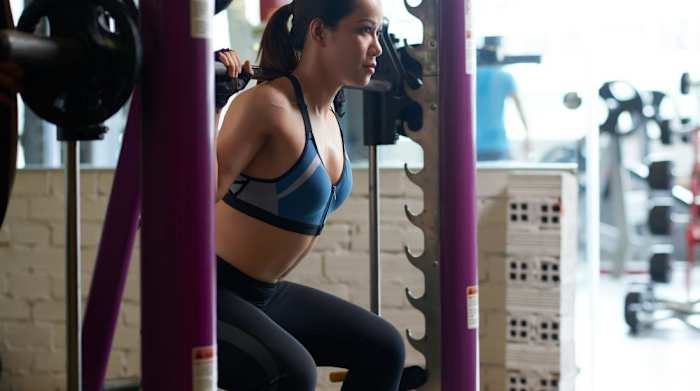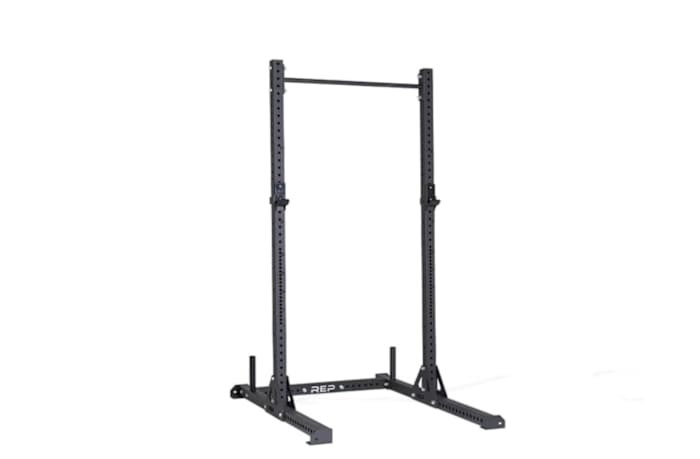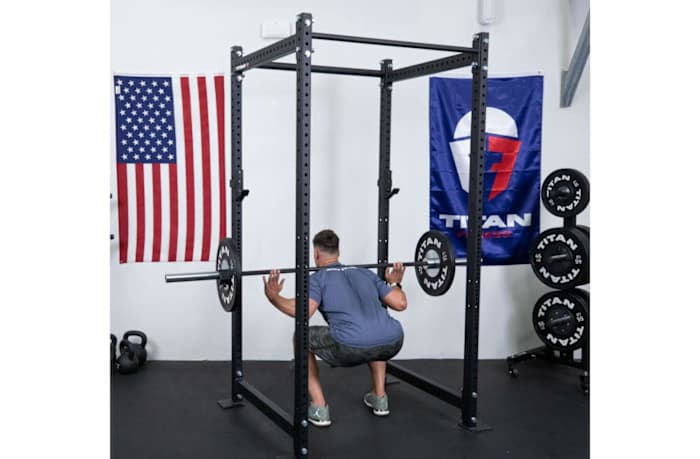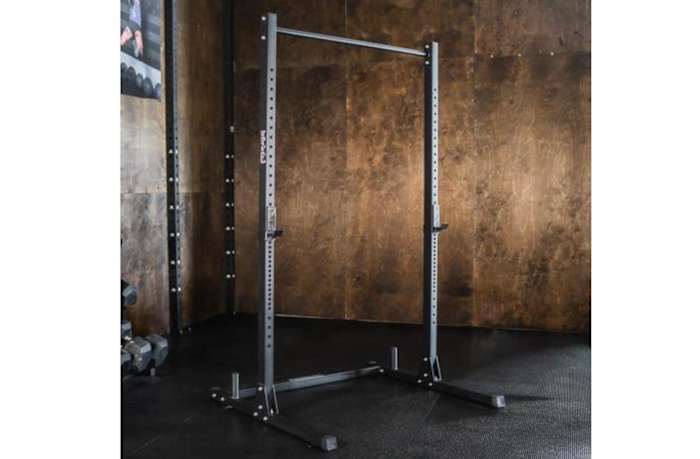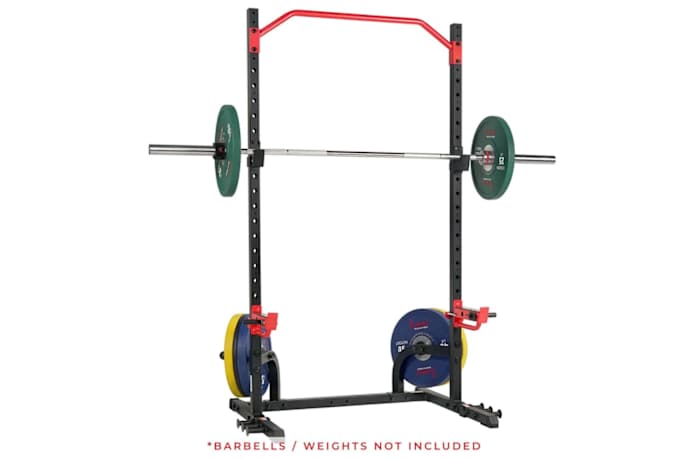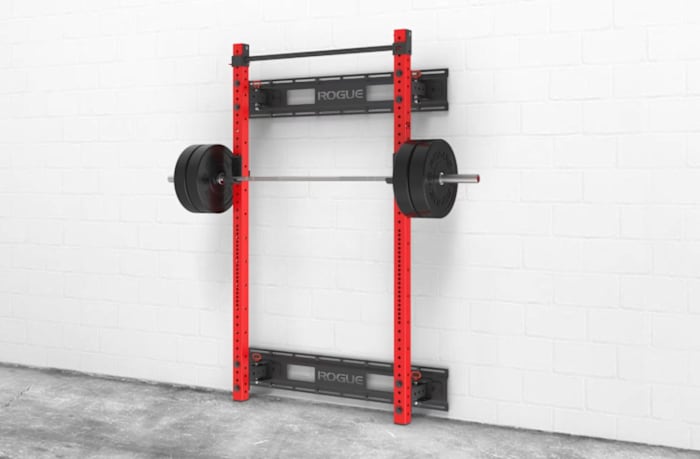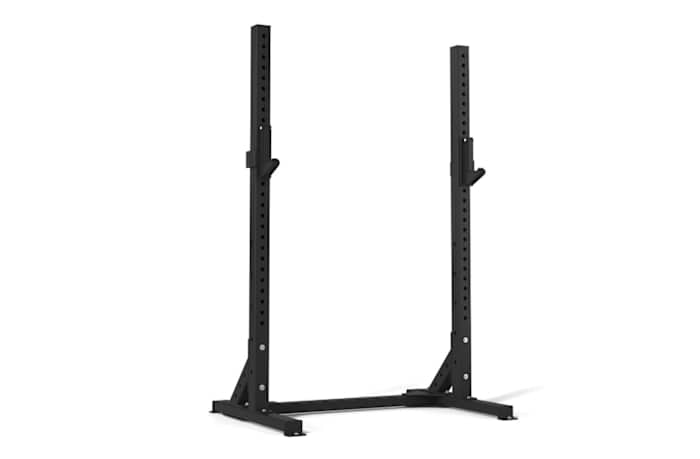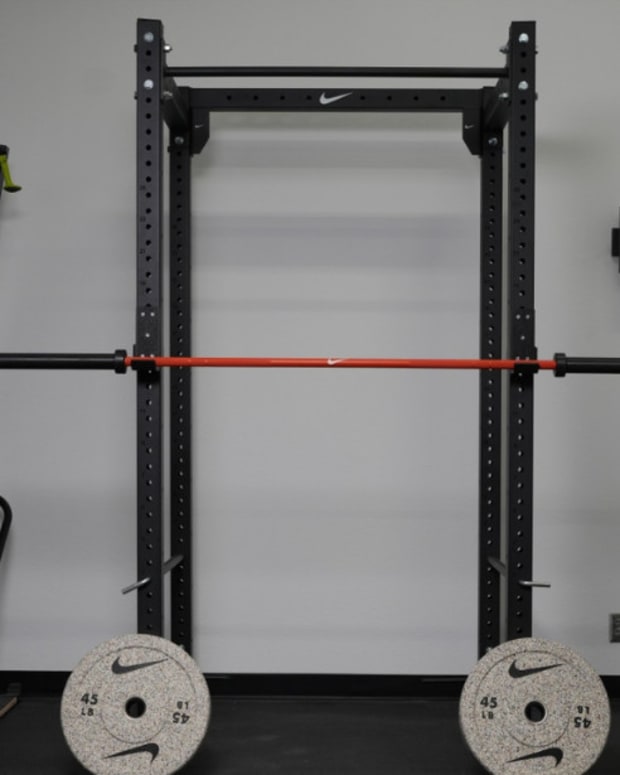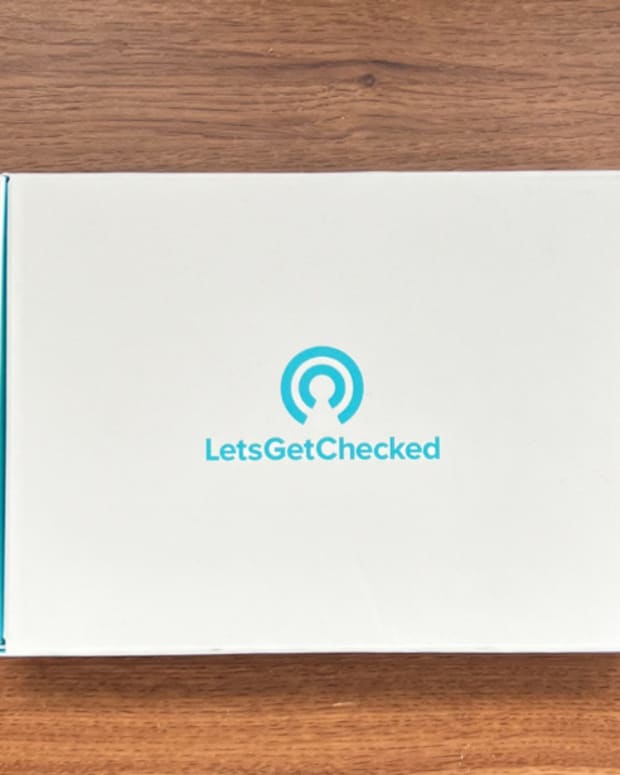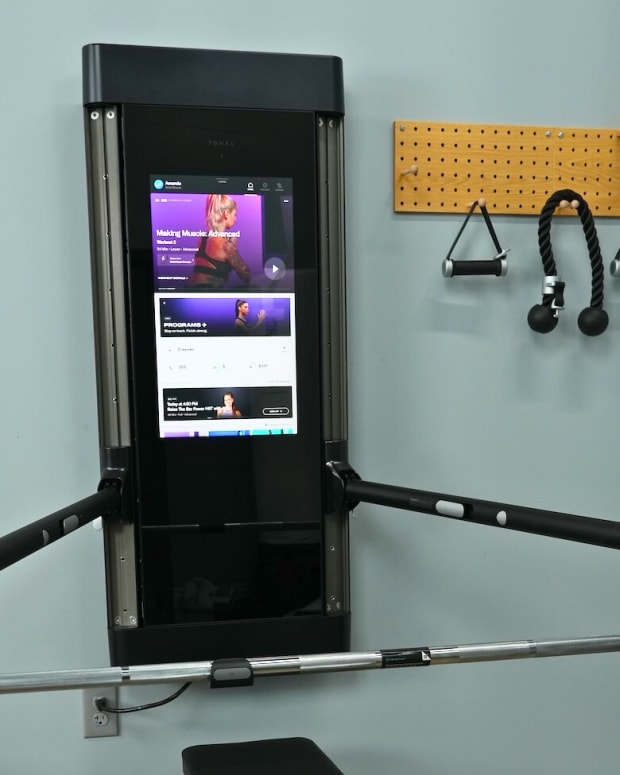The products featured in this article have been independently reviewed. When you buy something through the retail links on this page, we may earn commission at no cost to you, the reader. Sports Illustrated editorial staff are not involved in the creation of this content. Learn more here.
The squat rack is the heart of almost every traditional gym. As a versatile and durable piece of equipment, you can use squat racks to do an enormous range of workouts, from squats and bench presses to pull-ups or any other rack exercises. Buying a squat rack for your home gym, however, can be challenging. These large pieces of equipment are often big investments for the average DIY fitness enthusiast, which is why you have to do your research when buying one. To make your buying process easier, we’ve compiled the best home squat racks on the market in 2024, as well as characteristics to look for when buying a squat rack, how to use a squat rack safely and the benefits of performing squat rack exercises.
Our Picks for the Best Squat Racks of 2024:
- Best Outdoor Squat Rack: REP Fitness SR-4000 Squat Rack
- Best Foldable Squat Rack: Force USA Myrack Folding Power Rack
- Best Squat Rack with Pull Up Bar: Titan T-3 Series Power Rack
- Best Garage Squat Rack: Fringe Sport Garage Series Squat Rack with Pull-Up Bar
- Best Squat Rack for Beginners: Sunny Health & Fitness Power Zone Squat Stand
- Best Wall Mounted Squat Rack: Rogue RML-3WC Fold Back Wall Mount Rack
- Best Budget Squat Rack: GetRXd Two-Piece Squat Rack
- Best Squat Stand: American Barbell Squat Stand
Best Outdoor Squat Rack: REP Fitness SR-4000 Squat Rack
Pros:
- Available in two heights (96-inches and 103-inches)
- Pull-up bar for back workouts and resistance band workouts
- J-Cups for barbell racking are included
- Bolt optional
Cons:
- Not the most versatile squat rack on this list
- Minimum height of 96-inches may be too tall for some home gym builders
- A bit pricey for a simple squat stand
Who it’s best for: Those who want an outdoor-ready squat stand and those with a primary focus on squats and bench presses
Who should look elsewhere: Those who want a highly versatile rack or a rack with a shorter minimum height
The REP Fitness SR-4000 Squat Rack has a 1,500-pound capacity and sturdy design without all the frills of more expensive squat racks. It’s available in two adjustable height options—96-inches and 103-inches—and is compatible with a wide range of REP’s 4000-Series add-ons. Although the SR-4000 has only two vertical bars (instead of four), the flat-footed design and long base make it sturdy enough to allow you to perform high-movement exercises safely, such as kipping pull-ups. It’s also made with durable 11-gauge steel and has pre-drilled feet that you can bolt into the ground if needed. While it’s made with similar materials to most of the other racks on this list, the reason we pegged it as the best outdoor squat rack is its height. With a 103-inch max height, users can utilize the full height of the rack outside, without the limitations of their indoor ceiling height.
Best Foldable Squat Rack: Force USA Myrack Folding Power Rack
Pros:
- Folds up for storage
- Included lifetime warranty
- Comes with multiple attachment options
- Highly customizable
Cons:
- 12-gauge steel isn’t as strong as other racks, which often use 11-gauge steel
- Attachments sold separately
Who it’s best for: Those who want a unit that folds up for storage and those who want lots of attachments
Who should look elsewhere: Those who want to use their own attachments and those looking for the most durably squat rack available
The Force USA Myrack is one of the most versatile squat racks on the market today, great for those who want all of the bells and whistles, while enjoying the safety of a reliable piece of equipment. While the 12-gauge steel might not be as strong as 11-gauge steel found on most other racks, the portability of the foldable design is where the Myrack shines. Plus, it comes with a lifetime warranty, which is much longer than the limited warranties offered by most competitors.
The rack is equipped for up to 2,000 pounds, more than enough weight for heavy lifters and more than the average squat rack can hold, which is often between 700 and 1,500 pounds. It has Westside Barbell hole spacing, which means the holes are closer together near the bottom and further apart near the top. It also excels in customizability: You can add up to 10 attachments (a bit less than more versatile squat racks like Titan Series racks, which offer 40+ attachments), including a landmine, dip bars, an additional seat, a cable pulley system and a lat pulldown setup, to name a few. It’s worth noting that the dimensions on the uprights (vertical columns) force you to buy the company’s attachments. While the upfront cost of all of these attachments can seem like a lot, you won’t need to add any additional equipment once you have them.
Best Squat Rack with Pull Up Bar: Titan T-3 Series Power Rack
Pros:
- Available in two height settings (82-inches and 91-inches)
- Available in two depth settings (24-inches and 36-inches)
- 40+ Titan attachments to choose from
- Westside Hole Spacing (allows for more granular adjustment of bars and accessories)
Cons:
- Must be bolted down
- Some US attachments may not fit with metric sizing
Who it’s best for: Those who want to perform pull-ups and those who want a large variety of attachments
Who should look elsewhere: Those who do not want to bolt down their rack and those with only US attachments
The Titan T-3 Series Power Rack was modeled after some of Westside’s old-school power racks. Westside spacing offers holes that are one-inch apart for more precise bar and accessory placement. You also get the addition of the pull-up bar to make your workouts more versatile, allowing you to work your back, shoulders, abs and biceps.
The Titan T-3 utilizes a low-profile build with a versatile design, which is great for beginners who are looking for a rack to grow into. With that said, it’s also suitable for heavy lifters, thanks to its 1,000-pound capacity. The smaller version of the Titan T-3 is made with high-quality 11-gauge steel with a relatively small footprint of 24 inches deep by 54 inches wide.
When purchasing, you can choose a height of either 82-inches or 91-inches, and a depth of either 24-inches or 36-inches, depending on your space. Because it’s a smaller four-post rack, it’s highly recommended that you bolt the rack down to create total stability. While it feels fairly stable on its own, most users want extra security while performing pull-ups or squatting heavy weights off the front of the rack.
It’s also important to note that the T-3 uses 17.5-millimeter holes, while most imperial-based racks use 15.9-millimeter holes. Because the holes on this rack are a bit larger than most, you can expect a slight wobble when using imperial-based equipment. Luckily, Titan makes lots of attachments, so creating a relatively versatile unit won’t be very difficult.
Best Garage Squat Rack: Fringe Sport Garage Series Squat Rack with Pull-Up Bar
Pros:
- Budget-friendly
- Affordable accessories compared to other brands
- Comes with an integrated pull-up bar
Cons:
- Two-inch x three-inch 12-gauge steel isn’t as strong
- Only one year of warranty coverage
- Spotter arms aren’t the strongest
Who it’s best for: Those who want a basic, budget-friendly rack
Who should look elsewhere: Those who are serious powerlifters
If you’re in the market for a basic, inexpensive squat rack for your garage gym, then the Fringe Sport Garage Series Squat Rack is one of the best options on the market today. It comes with an integrated pull-up bar, as well as spotter arms and dip horns, which can be purchased separately for much cheaper than other brands. While you save plenty of money buying this rack over others, note that it is pretty basic in its use, and we wouldn’t recommend it for serious powerlifters.
Best Squat Rack for Beginners: Sunny Health & Fitness Power Zone Squat Stand Power Rack
Pros:
- Comes with an angled pull-up bar800-pound capacity
- Priced lower than many other racks on the market
Cons:
- Not suitable for people six-foot, four-inches and above
- Must buy weight plates and bars separately
Who it’s best for: Those who are just getting into lifting
Who should look elsewhere: Those who want a full set
If you’re just getting into the world of lifting and you want a no-frills squat rack with a solid capacity and an angled pull-up bar for workout versatility, the Sunny Health & Fitness Power Zone Squat Stand Power Rack is one of the best on the market.
If you want to take your fitness game even further, you can add a weight bench or lat pulldown to the equation. As one of the most popular budget squat racks on Amazon, there are many positive reviews. Many people even say they have the ability to do intense workouts, such as kipping pull-ups, without the rack ever feeling unstable.
Best Wall Mounted Squat Rack: Rogue RML-3WC Fold Back Wall Mount Rack
Pros:
- Rotating hinge system for folding away when not in use
- Comes in a wide range of colors
- Laser-cut stringer system makes installation very easy
Cons:
- Pricey
- Can be a pain to fold up
Who it’s best for: Those who need to optimize their space
Who should look elsewhere: Those who want a budget-friendly rack
The Rogue RML-3WC Fold Back Wall Mount Rack is a unique wall-mounted rack unit that you can fold inward or outward, depending on your spatial needs. While the folding capabilities are certainly not the most convenient, having the ability to fold it up when you need to gives it the advantage over many other squat racks for small spaces. The hinge-and-pin system that makes this rack super easy to install also makes it feel much lighter when folding back.
Best Budget Squat Rack: GetRXd Two-Piece Squat Rack
Pros:
- Easy to assemble
- Very affordable
- Portable design
Cons:
- Very basic in use
- Must be cautious when putting the barbell back on the rack since the racks aren’t connected or bolted down
Who it’s best for: Budget-minded beginner and intermediate lifters
Who should look elsewhere: Those looking for a more commercial-style machine or those who want extra features like a pull-up bar
The Get RXd Squat Rack is a two-piece squat rack designed for easy storage and transportation. When you’re all done lifting, you can place it back in storage for maximum space saving. Each of the racks comes with a wide base, ensuring stability.
While it’s certainly not the most versatile piece of equipment on this list, it does come with a lower second set of arms, giving you a few different options for lifting. The height ranges from three-feet, one-inch to five-feet, seven-inches, making it a solid choice for lifters of all sizes. The weight capacity is 500 pounds, which is good for beginners and those who are building up to pumping hundreds of pounds.
Best Squat Stand: American Barbell Squat Stand
Pros:
- More compact than traditional squat stands
- Support braces keep stand securely in place
- Comes with j-hooks
Cons:
- Same price range as full squat racks on this list
- No pull-up bar attachment
Who it’s best for: Beginner and intermediate weightlifters tight on space
Who should look elsewhere: Shoppers on a budget who want extra accessories with their purchase
Squat stands are a great pick for home gym weightlifters and anyone who is trying to make the most of a small gym setting. Since squat racks take up a bit of space, stands cut those dimensions in half by having two upright poles secured by support braces. This rings true for the American Barbell Squat Stand, designed to remain steadfast during challenging lifts. Full-length holing doesn’t limit you to just squats, but a range of other exercises such as bench presses and deadlifts. Like most squat racks and stands, you’ll need to supply your own barbell, but you’ll get two sturdy j-hooks with this squat stand.
Keep in mind that squat racks like the American Barbell are better suited for beginner and intermediate lifters––since there are no safety brackets, advanced lifters should opt for more spotter features.
Benefits of Using a Squat Rack
Efficiency
When performing squats, you work a wide range of muscles in a single movement. Squats target your quads, back and core, all while activating your glutes and calves to improve your overall core strength. If you’re looking for a single piece of equipment that can target multiple muscle groups at once, look no further than a quality squat rack.
Core strength
When you perform a squat, you fully engage your core, which helps to strengthen it. With a stronger core, you can reap plenty of other physical benefits, such as better posture, better balance and better overall fitness.
Intuitive
Squat racks can make performing weighted squats or other types of exercises much easier. Squat racks are made to be intuitive pieces of equipment that allow people to push their strength and athletic abilities. These kinds of machines make it easier for weight lifters to push through plateaus they hit along the way.
Safety
Squat racks were originally made to provide spotting and support for various barbell exercises, from squats to bench presses. With the holes found on the uprights, users were able to adjust the height of the hooks and barbell to their preferences. With this design, people can lift more safely without having to worry about dropping a barbell onto the floor or getting hurt when they have to ditch the bar when they hit failure.
Pro Tip: The best racks for optimizing spotting are power racks, as they have anywhere from four to six columns, which you can step “inside” to use the safety bars. Lifting straps can also be an excellent accessory for supporting your wrists and hands during lifts, and weightlifting belts help to support and prevent injury in your lower back.
Versatility
While they are called squat racks, it’s clear that these pieces of equipment are for more than just squats. You can use them for a wide range of exercises. Even if you only have a minimalist squat rack, you can perform a variety of exercises, including front squats, back squats, bench press, military press, overhead press, shoulder press, bent-over rows, skull crushers and more.
As you begin adding accessories and attachments, your workouts can get even more versatile. Whether you choose to add a pulley system, a pull-up bar or a bench, you’re rarely limited when you have a high-quality squat rack at your disposal.
How to safely use a squat rack
One of the most crucial aspects of using a squat rack is safety. To help you use your squat rack safely and confidently, follow these steps:
Adjust the height of the rack
If your rack is set too high or too low, squatting can be quite risky. When you adjust the height of your rack, you want to make sure that the barbell sits right around the height of your chest. Once there, you can make slight adjustments to optimize your performance.
Load the bar
Before you begin grabbing your plates, calculate how much you plan to lift. It’s crucial to load both sides of the bar with the same amount of plates before you get underneath it. To keep the plates from shifting around while you lift, you can secure your plates using clips.
Balance the bar
No matter what type of lifting you are doing, stability is essential. If you’re squatting with a heavy weight, stability is even more important. Distribute the weight of the bar evenly atop your shoulders with your knees slightly bent to create balance as you lift it off the rack.
Lift and step back
When you feel stable, slowly press away from the ground to take the barbell off the rack. You should feel complete balance during this process. Next, step back a few inches from the rack. These few inches should give you enough clearance to squat without hitting the rack.
Begin your squat
With your feet shoulder-width apart, turn your knees slightly out to keep them from buckling inwards. To optimize your squat, squat down until your hips drop beneath your knees while keeping your chest up and your knees out. Then, move back up to your starting position.
Set the bar down
After completing your preferred number of reps, put the bar down to take a quick rest before your next set. Carefully place the barbell back on the rack while maintaining your balance. Before setting it back on the rack, ensure that both sides are in place.
What to Look for in a Squat Rack
Style
There are many styles to choose from in the world of squat racks, including power racks, half racks, squat stands and folding racks. There are pros and cons to each of these styles.
Power racks, often referred to as power cages, are the most versatile and widely available. They also come with several high-end safety features. These look like large boxes that you stand inside when lifting. The four-post design is one of the safest options out there.
Half racks, as you may have guessed, are half power racks. While they don’t offer the same level of safety as power racks, they are still very popular choices, thanks to their space-saving designs, relatively low prices and open construction. With that said, half racks still offer more safety than squat stands, and many of them come with additional features.
Squat stands are free-standing squat racks. Unlike power racks and half racks, people don’t often bolt these to the floor or wall. These pieces of equipment have been around for quite some time and have increased in popularity over the past few years, thanks to their additional features and increased stability. However, because they don’t have the same safe designs as power racks and half racks, it’s crucial to do your research when looking for the right one so you can find one that’s safe and enjoyable to use.
Folding squat racks are new and innovative squat racks that have popped up over the past couple of years. Most of them are extremely sturdy and fold away using space-saving designs. While most of these units only come with two posts, they have plenty of custom features available.
Durability
When it comes to heavy-duty squat racks, you’ll most often find 11-gauge steel construction. The best squat racks on the market use this material, and the beauty of 11-gauge steel is that it’s actually much stronger than anything you’d ever truly need. Some racks are made of 12-gauge steel, which is weaker steel; with that said, it’ll be enough for the average squatter.
Stability
Stability has a lot to do with construction. The heavier the materials and the better the design, the more stable your squat rack will be. A power rack will offer the most stability with its four-post design and braced back, while your average squat stand will offer the least amount of stability, as it usually comes in a two-piece design without a brace connection. You might also consider a bolted design vs a non-bolted design, as bolting your rack to the floor will provide you far more stability and peace of mind.
Weight capacity
Most home lifters will only ever put a few-hundreds pounds on their rack at once, and most racks are rated for a capacity of around 500+ pounds. Of course, if you’re an absolute monster, you might want to look for a rack that can hold anywhere from 1,000 to 2,000 pounds. Though you may not lift that heavy, a rack with this kind of capacity delivers peace of mind, as you don’t have to worry about the rack wobbling or collapsing under the weight.
Cost
Whether you want to pay a few hundred dollars or a few thousand dollars for a rack is up to you. However, while it’s easy to sway towards a budget buy, you have to consider quality. If you’re buying a rack for under a few hundred dollars, make sure you carefully read reviews and safety specs. Also, it’s important to note that the more you spend, the more versatile your rack will likely be. You can certainly spend less on a budget rack, though you may end up spending the same amount in the long run on accessories as you continue to add them on.
Space
Consider the amount of available space you have in your home. A power rack will take up the most space in width, depth and height. Most power racks are at least four feet by four-feet on the bottom, taking up lots of real estate. Average squat racks and half racks take up much less room, while folding racks fold away onto the wall to save additional space. You should also consider the fact that taller racks often have to be bolted to the floor for stability. If you can’t afford to sacrifice space for a bolted rack, you may want to go with a more portable option, such as a squat stand.
Safety Features
If you don’t already know by now, safety is one of the most essential factors to look for when buying a squat rack. We urge you not to consider racks that don’t come with pins, straps, bars or some sort of safety option. Using these kinds of safety features is the only way to avoid injuries, which is why you should always take advantage of the safety features available. Even if you have to pay a bit more for them, it’s better than shelling out a few thousand for that hospital bill after you drop a few hundred pounds on your foot!
Attachments
You need to decide how versatile you want your squat rack to be. The list of attachments in the world of squat racks is near-endless. Some squat racks come equipped with additional features, while others are equipped for them. Here are a few attachments to look for when buying a squat rack:
- Cables
- Landmines
- Dip stations
- Lat pulldown bars
- Pull-up bars
- Flywheels
- Utility seats
- Band pegs
- Gymnastic rings
Squat Rack FAQs
Is a power rack or squat rack better?
If budget and space aren’t issues for you, you might consider going with a power rack, as it’s far sturdier, safer and comes with more additional features. With that said, if you often need to relocate your equipment, don’t have the space for a power rack or are on a budget, a squat rack is a better choice.
What is the difference between a squat rack and a squat stand?
A squat stand is your basic piece of squatting equipment that uses two towers with holes drilled into them to lock brackets and a barbell in place. A squat rack, on the other hand, often has a wider base, customization options for rack accessories and one to two bars running across the back for additional support.
Can I deadlift or bench press at a squat rack?
Yes, you can deadlift and bench press with a squat rack, as this piece of equipment has racks built-in, allowing you to set your bar in place when you finish a set.
What muscles does a squat rack work?
A squat rack can work just about every muscle in the body, depending on the type of workout you perform. In a way, they combine the best elements of several pieces of equipment, allowing you to replace or supplement smaller products you might currently use, such as pull-up bars, kettlebells or benches. However, when performing a standard bodyweight squat, you target the following muscles:
- Quads
- Glutes
- Hamstrings
- Abs
- Calves
Do I need a spotter for a squat rack?
A spotter when squatting can be super helpful, as they can act as a safety net to catch the bar for you if you fail on a rep. If you plan on lifting heavy or maxing out, it’s a good idea to have a spotter with you.
Is a half rack or full rack better?
Full racks and half racks have their own benefits. While full racks take up much more space and cost more, they are more versatile and much sturdier. Half racks are a better choice for those who have limited space or are on a tighter budget.
Final Thoughts
A quality squat rack can be the heart of your home gym. After all, squats are one of the most important lift exercises you can do. Of course, even beyond heavy squats, you can use these pieces of home gym equipment to perform a wide range of full-body exercises. Figure out the types of workouts you want to do most, and use our guide above to find the right piece of equipment for your space, budget and needs.
Prices are accurate and items in stock as of publish time.
